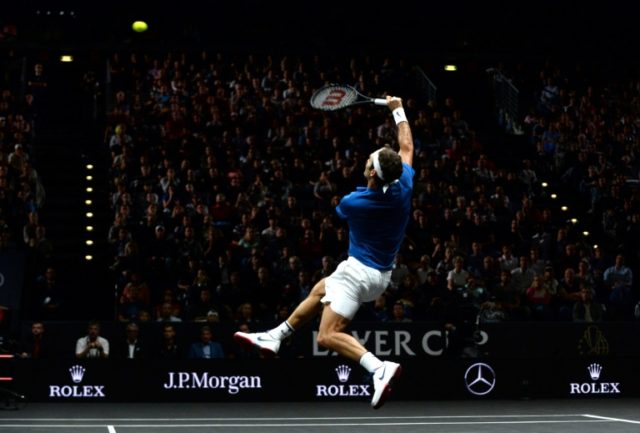Roger Federer saved a match point and edged Nick Kyrgios in the third set of the last match of the Laver Cup Sunday night in Prague O2 arena, clinching the inaugural edition of tennis’s newest tournament, a team competition pitting top Europeans against the best from everywhere else, though for the time being this means the Anglosphere.
The remarkable rally after the Swiss great dropped the first set and fought through a thrilling second set tiebreak saved the day and the tournament for the Euros after Georgia’s John Isner stunned world No. 1 Rafael Nadal.
It was the first time the tall American beat the Spaniard, and following a victory in doubles with Jack Sock just hours before, it put the Anglosphere team within striking distance of victory. Federer dashed the English-speaking team that confounded the experts who had predicted a rout.
Conceived by Swiss great Roger Federer as a best-of-the-best tournament, the Laver Cup, named to honor Australia’s legendary Rod Laver (who was present) underscores the globalization of professional sports. Tennis has been international from the beginning in the sense that it is played everywhere, but teams representing vague entities like “Europe” and “the World,” are indeed an innovation.
The prize money is nothing to scoff at, reportedly a quarter million for each member of the winning team, probably half that for the losers if the sponsors follow current tournament norms. Appearance fees, if any, were not reported. Globalization is nice work if you can get in on it.
The three day series consists of nine singles and three doubles matches. Team captains – John McEnroe for the World and Bjorn Borg for Europe, must select the highest ranked available players from their regions, and two more of their choice.
Team World would not have been strictly Anglosphere, but McEnroe’s choice of Juan-Martin del Potro was overtaken by health issues. McEnroe, who coached actively during matches (permitted in team competitions, including the Davis Cup), replaced the Argentine ace with young American Frances Tiafoe (who lost honorably to Marin Cilic in two sets, both requiring tiebreaks.) Kyrgios and Canada’s Denis Shapovalov were the only non-U.S. players.
The value of each win increases every day by one point. While this may seem a gimmick to traditionalists mindful of the Davis Cup, it explains why the World team had a chance when down three-nine at close of play on Day Two. With 13 points needed to clinch, the Euros needed two wins out of the four scheduled on Day Three.
The score was 12-9 for the Euros after Isner beat the great Nadal, capping a fantastic day that began with his win alongside Jack Sock over Marin Cilic and Tomas Berdych. Alexander Zverev beat Californian Sam Querrey, but a win by Kyrgios would have evened the score and precipitated a deciding match in for shape of a one-set doubles.
Possibly it was due to the very high quality of the players, but the innovations did not subvert the sense that the tournament was bringing out some of the best playmaking the sport can offer.
The chief objection, which will be negated or verified after two or three more Cups are played (Chicago hosts next year), will center around the issue of physical and mental endurance, which is so much a part of the sport. Do these abridged matches (“speeded up,” in polite language) represent real tennis?
If future teams put as much heart and enthusiasm into their matches as these two demonstrably did (even as seen on t.v.), the question will answer itself. A fall classic of sorts, in between the season’s last great players’ tournament – the U.S. Open – and the Masters’ Final in November for the top eight players, the Laver’s Cup may well become, much like the Ryder Cup, a chance for the Old World to take the measure of the New, at least for an intense weekend on a rectangular surface, 78-by-27 feet or, if you prefer, 23-by-8 meters.

COMMENTS
Please let us know if you're having issues with commenting.